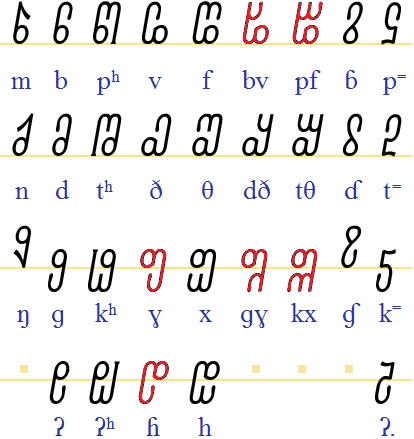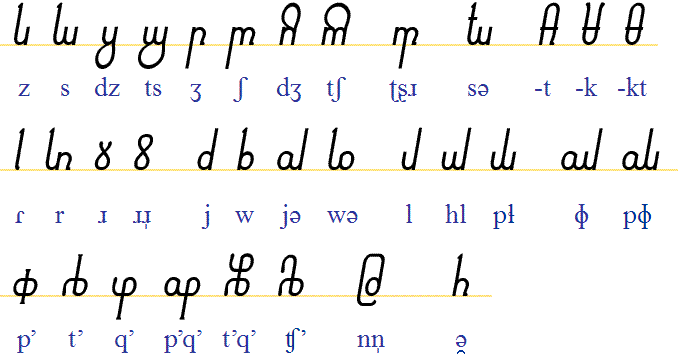This is an easily written, phonetically constructed script, which began as a new entry in my Phonological Cypher series. It soon came to include all the phonemes of the Sgai language, and is now a preferred SIGIL script, along with Slinseng-Fi and Slinsen-Yi.
Consonants
This shows the main sequence of forms, across four consonantal locations. Letters marked in red are not used in the Sgai language. When used in final position (closing a syllable), the letters for implosive and unaspirated unvoiced plosive become voiced and unvoiced unreleased stop, respectively. All consonants are either taller than the x-height, or descend below the baseline. Plosives and affricates have an implicit voiced or unvoiced schwa, which emerges if no explicit vowel follows.
These are the sibilants, semivowels and other consonants.
Vowels
This is the simple, final (open-syllable) form of vowels. They have no ascender or descender, rising only to the x-height.
To show the vowel is followed (closed) by a consonant coda, the right leg is extended down. If the vowel is nasalized, a more elaborate extension is drawn. Note that vowel [r] is only either open or nasalized in Sgai.

In the event of requiring dipthongs, [i], [turnedm] and [y] can be used as the second sound of the narrowing kind. Instead of the bulky [u], the semivowel [w] is preferred. For the widening kind, use [babygamma] or the “semivowel” type of [schwa] shown in the consonant section above. If nasalizing is required for [-w] or [-schwa], the extension shown under vowel [r] can be used.
Other symbols
There are marks to show long vowel, rising tone, falling tone, low tone and high tone. There are three levels of caesura for punctuation. European ? and ! may also be used if necessary. Some unvoiced consonants may take a suffix to show inward airflow.
Examples
1 English. This is the beginning of Shakespeare’s sonnet 18 again (transliteration only), for comparison with other versions of SIGIL etc.
“Shall I compare thee to a summer’s day?
Thou art more lovely and more temperate;
Rough winds do shake the darling buds of May
And summer’s lease hath all too short a date.”
2 Thai, from a famous fairy tale. See also the Tai Anphabet version.
“Once upon a time
there was a young lady named Phikul.”
3 Sgai. This is the beginning of the Tower of Babel text translated into Sgai. See also the Slinseng-Fi version.
“And the whole earth was of one language, and of one speech.
And it came to pass, as they journeyed from the east, that they found a plain
in the land of Shinar; and they dwelt there.”
A version of this page can be found on
Omniglot.







